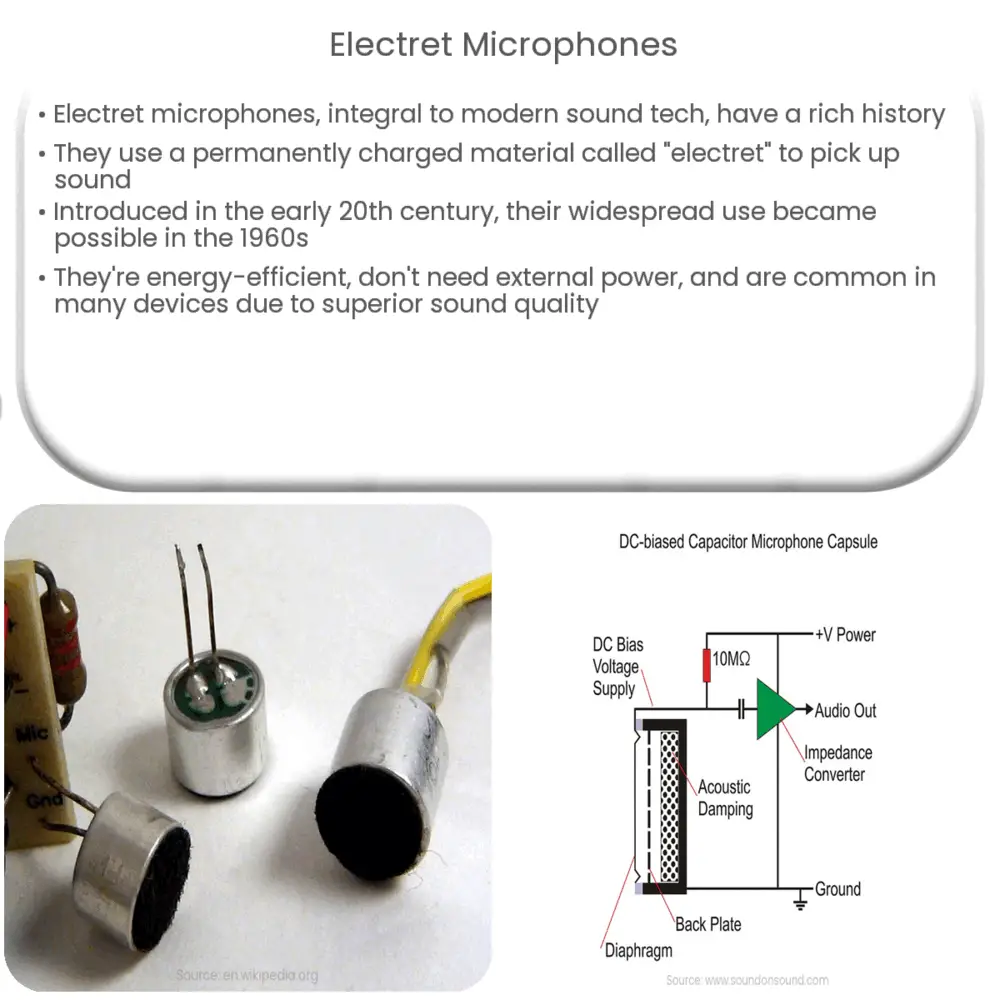An error occurred. Either the engine you requested does not exist or there was another issue processing your request. If this issue persists please contact us through our help center at help.openai.com.

Understanding Electret Microphones
Electret microphones, also known as condenser microphones, have become an integral part of modern sound technology. They have a rich history and an even richer functionality which has propelled them to the frontlines of audio technology. Let’s delve into what makes electret microphones special.
Defining Electret Microphones
An electret microphone is a type of condenser microphone that uses a material known as an “electret” to provide a permanent charge. The word “electret” is a portmanteau of “electric” and “magnet”, mirroring the term “magnet” that stands for a permanently magnetized material.
These microphones use an extremely thin, permanently charged material called an electret film to pick up sound waves. When sound waves hit the film, they cause it to move. This movement generates a corresponding electrical signal, which can then be amplified and processed into a sound we can hear.
The History of Electret Microphones
The concept of the electret microphone was first introduced in the early 20th century, but it wasn’t until the 1960s when the first practical electret microphones were developed. The material science advancements in this era enabled the creation of a permanently charged film, making the widespread use of electret microphones possible. SONY was the first to commercialize this technology in 1962, and the market has grown exponentially ever since.
The Working Principle of Electret Microphones
The functionality of electret microphones is based on capacitance and the changes it undergoes when subjected to sound pressure. In simple terms, an electret microphone consists of a diaphragm (the electret film) and a metal plate (the backplate), both of which form a capacitor. When sound waves hit the diaphragm, it vibrates, altering the distance between it and the backplate. This change in distance alters the capacitance, which in turn modulates the voltage across the capacitor. This modulation is then converted into an electrical signal corresponding to the sound.
While electret microphones operate similarly to other types of condenser microphones, the key difference is that they have a permanent charge. This eliminates the need for an external power source to polarize the microphone’s element, as is necessary with other condenser microphones. Therefore, electret microphones are more energy efficient and practical for a wider range of applications.
Applications of Electret Microphones
The versatility of electret microphones makes them a popular choice for a broad array of applications. They are commonly found in devices such as smartphones, laptops, and digital recorders, as well as professional-grade audio equipment. This wide use is due to their superior sound quality, consistency, and excellent frequency response.
Advantages of Electret Microphones
- Electret microphones are highly sensitive and capable of picking up even very soft sounds. This makes them ideal for applications such as studio recording and live sound reinforcement.
- These microphones offer superior frequency response, ensuring that they reproduce sounds accurately across a wide range of frequencies.
- Electret microphones are typically smaller and lighter than other types of microphones, making them convenient for portable applications.
- Unlike other condenser microphones that require an external power source, electret microphones carry a permanent charge, making them more energy-efficient and convenient.
Disadvantages of Electret Microphones
- While they are sensitive, electret microphones can sometimes be too sensitive, picking up unwanted background noise.
- Electret microphones have a limited lifespan as the charge in the electret material will eventually dissipate over time, although this process may take many years.
- They may not be as robust as dynamic microphones, and can be damaged by very loud sounds or by rough handling.
Conclusion
In conclusion, electret microphones, with their superior sensitivity, sound quality, and convenience, have revolutionized the world of audio technology. Despite their disadvantages, their versatility and wide range of applications have made them the preferred choice in many audio environments, from consumer electronics to professional sound recording. As technology continues to advance, the design and manufacturing of electret microphones will also likely improve, providing even better sound quality, longevity, and versatility in the future.

